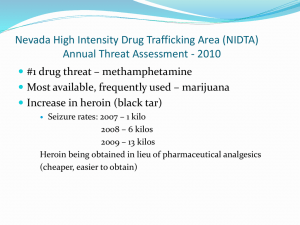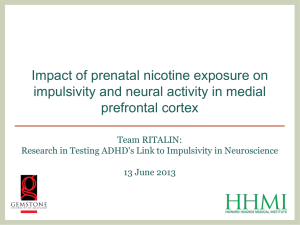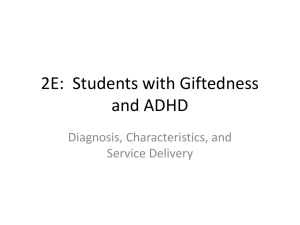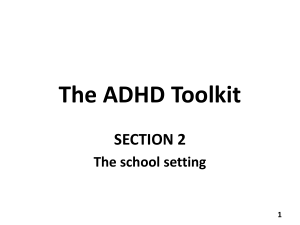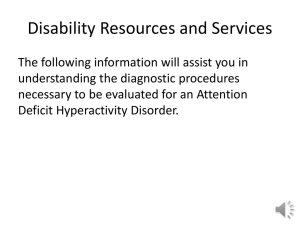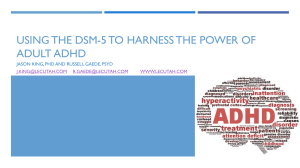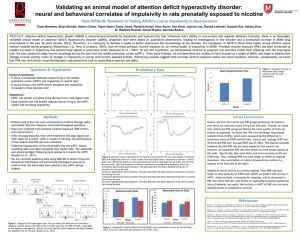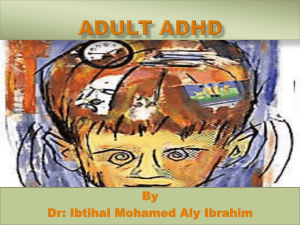Thesis Proposal Presentation
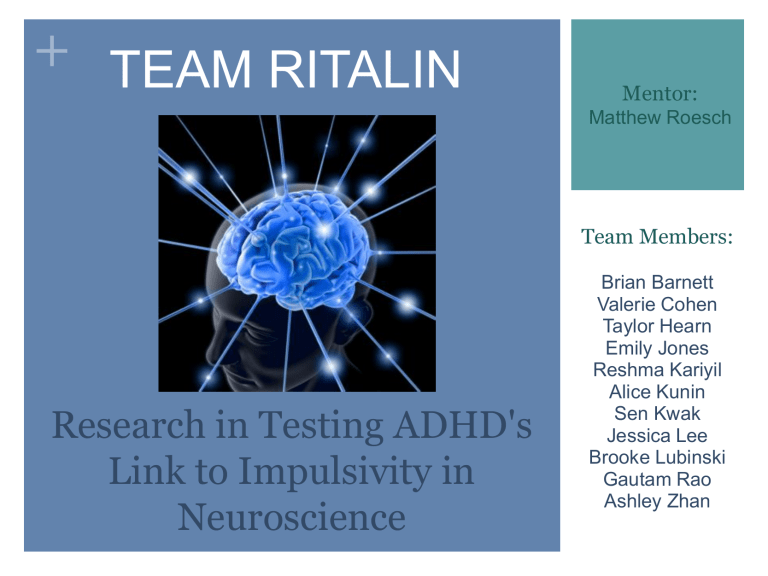
+
TEAM RITALIN
Mentor:
Matthew Roesch
Research in Testing ADHD's
Link to Impulsivity in
Neuroscience
Team Members:
Brian Barnett
Valerie Cohen
Taylor Hearn
Emily Jones
Reshma Kariyil
Alice Kunin
Sen Kwak
Jessica Lee
Brooke Lubinski
Gautam Rao
Ashley Zhan
+
Introduction
ADHD (Attention Deficit Hyperactivity Disorder)
“In 30 years there has been a twentyfold increase in the consumption of drugs for attentiondeficit disorder”
(Sroufe, 2012)
Limited research on the neurobiology of the disorder
Diagnoses are made based on subjective, behavioral observations rather than reliable objective identifiers
Frequent misdiagnoses and rising medical costs
+
Importance of Our Project
No valid animal model of ADHD developed yet
Women who smoke during pregnancy are three times as likely to have children diagnosed with ADHD
(Linnet et al., 2005)
Validating the fetal nicotine rat model to further study
ADHD
Research valuable to scientists, psychiatrists, pharmacists, drug companies, patients, and relatives of patients
+
Literature Review: Impulsivity
Impulsivity
Clinical characteristic of ADHD
The ability to stop an ongoing or habitual movement
Stop-Signal Task
Performance is worse in humans with ADHD and in proposed animal models of ADHD
(Bari et al., 2011)
+
Literature Review: Neurophysiology
Dorsal Prelimbic Cortex (dPL)
Previously associated with controlling impulsive behavior
Pharmacology
Dopamine & DAT
Noradrenaline
Monoamine oxidase
Nicotine
(Vertes, 2004)
+
Literature Review: Adderall
25% of all prescriptions written for ADHD
(Sallee & Smirnoff, 2004)
Composed of D-amphetamine and L-amphetamine
Increases the amount of postsynaptic dopamine and noradrenaline
Change in conformation and inhibition of dopamine transporter
Inhibition of monoamine oxidases A and B
+
Literature Review: Fetal Nicotine Rats
Face validity: increased stop-signal reaction time, decreased percent correct stop trials
Construct validity: decreased firing in the dPL cortex following stop signal
Predictive validity: altered dPL firing and stop-signal performance reversed by Adderall administration
(Sontag, Tucha, Wlitza, & Lange, 2009)
+
Research Questions & Hypotheses
How will neural firing in the dorsal prelimbic cortex and stopsignal task performance differ between control, fetal nicotine, and Adderall-administered rats? Will these neural differences be sufficient to validate the fetal nicotine rat as an animal model of ADHD?
Hypothesis: Fetal nicotine rats will exhibit reduced neural firing in the dPL cortex and worsened stop-signal task performance as compared to the control group. Adderall administration will increase dPL activity and improve task performance in fetal nicotine rats.
+
Methodology: Variables
(Schoenbaum, 2000)
Variables
Independent Variables
Drug administration
Stop-signal timing
Dependent Variables
Neural recording
Task performance
Rat behavior
Test Groups
Control: Control rats + saline
Experimental 1: Fetal Nicotine rats + saline
Experimental 2: Fetal Nicotine rats + Adderall
(Bari et al., 2011)
+
Methodology: Procedure
+
Timeline
Spring
2012
IACUC approval
Apply for grants
Build electrodes
Summer
2012
Fetal
Nicotine
Pilot Study
Fall 2012
Exp.
Group 1
Control
Group
Junior
Colloquia
Spring
2013
Exp.
Group 1
Exp.
Group 2
Histology
Studies
Fall 2013
Data analysis
Write
Thesis paper
Spring
2014
Complete
Thesis paper
Senior
Thesis
Conference
+
Anticipated Results & Scientific
Impact
Physiological & neurotransmitter pathway disruption in inhibiting impulsivity
Repaired with Adderall
Nicotine exposure as cause of ADHD
Fetal nicotine rats as valid model of ADHD
Applicable to humans
+
References
Bari, A., Mar, A.C., Theobald, D.E., Elands, S.A., Oganya, K.C., Eagle, D.M. & Robbins, T.W. (2011) Prefrontal and monoaminergic contributions to stop-signal task performance in rats. Journal of Neuroscience, 31,
9254-9263.
Jensen, P.S., Kettle, L., Roper, M.T., Sloan, M.T., Dulcan, M.K., Hoven, C., Bird, H.R., Bauermiester, J.J., &
Payne, J.D. (1999). Are stimulants overprescribed? treatment of ADHD in four U.S. communities. Journal of
the American Academy of Child & Adolescent Psychiatry, 38, 794-804.
Linnet, K., Wisborg, K., Obel, C., Secher, N.J., Thomsen, P.H., Agerbo, E., & Henriksen, T.B. (2005) Smoking during pregnancy and the risk for hyperkinetic disorder in offspring. Pediatrics, 116(2), 462-467.
Sallee, F. R., & Smirnoff, A. V. (2004). Adderall XR: long acting stimulant for single daily dosing. Expert
Review of Neurotherapeutics, 4(6), 927-934. doi: 10.1586/14737175.4.6.927
Schoenbaum, G. Olfactory Learning and the Neurophysiological Study of Rat Prefrontal Function. In:
CRC Series: Methods and Frontiers in Neuroscience. Edited by S.A. Simon and M.A.L. Nicolelis, CRC
Press, NY, 2000.
Sontag, T. A., Tucha, O., Walitza, S., & Lange, K. W. (2010). Animal models of attention deficit/hyperactivity disorder (ADHD): a critical review. ADHD Attention Deficit and Hyperactivity Disorders, 2(1), 1-20. doi:
10.1007/s12402-010-0019-x
Sroufe, A. L. (2012, January 28). Ritalin Gone Wrong. The New York Times. Retrieved from http://www.nytimes.com/2012/01/29/opinion/sunday/childrens-add-drugs-dont-work-longterm.html?_r=1&pagewanted=all
Vertes, R. P. (2004). Differential projections of the infralimbic and prelimbic cortex in the rat. Synapse. 51
32-58. DOI 10.1002/syn.10279.
+

